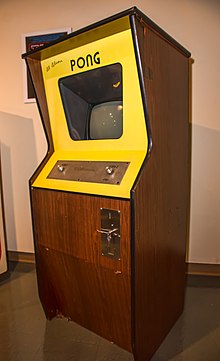History of video games/Games/Pong and Breakout
Atari, Inc.'s Pong and Breakout are two of the most significant arcade video games in History. They were, respectively, a table tennis (ping-pong, from which the name) simulator and a wall-breaking simulator, released the former in 1972 and the latter in 1976. Pong became a pop culture icon, while Breakout started a whole clone video game genre Their chronology is listed below:

Pong
editPong is one of the earliest arcade video games, being notorious for its significance in video game history. It was manufactured by "Atari Corporation Syzygy Engineered" (as the publicity flyer reads[1]) and first released in 1972. It consisted of a rough table tennis simulator, possibly inspired by 1958's Tennis for Two (but more likely by the Magnavox Odyssey, bringing the similarities in court), with two white vertical one-dimensionally-moveable dashes symbolizing two rackets controlled by as many users via one potentiometer paddle each and a white, two-dimensionally-moving, dot symbolizing the ball. Each time the ball (which could bounce only on the two rackets or on the two horizontal borders of the screen) exited the screen on one of its two sides (even if it bounced on that side's defender's racket), the player on the other side gained a point, and the first player to gain eleven (or fifteen, depending on the settings[2]) points won the one-quarter-costing virtual match[3]. Below is a chronology of Pong's history.
- 1972-11-29: The Pong upright arcade cabinet is released.
- 1972/1973: Atari, Inc.'s Barrel Pong upright arcade cabinet (shaped like a table with a barrel on, in which the monitor is) is released by Hunter Electronics Pty.[4][5].
- 1973: The Pong-In-A-Barrel half-barrel-shaped cocktail arcade machine is released.
- 1973: The four-player Pong Doubles upright and cocktail arcade machines are released.
- 1973: The TV Ping Pong upright arcade cabinet is released by Amutronics, Inc.[3][6].
- 1973-10: The four-player Elimination cocktail-like arcade machine is released by Kee Games on license from Atari, Inc.. Players play on the four sides of the screen-table.
- 1974: The Rebound upright arcade cabinet, simulating a game of volleyball, is released.
- 1974: The Coup Franc cocktail arcade machine, somewhat resembling Pong-In-A-Barrel (1973), is released.
- 1974-02: The Superpong upright arcade cabinet, increasing the game's difficulty by having each player control three different rackets, adding a random element and varying the ball's velocity, is released.
- 1974-03: Atari, Inc. re-releases Elimination as Quadrapong.
- 1975: The Model 474 cocktail arcade machine is released by Digital Games[3][7]. It allows player-versus-AI gaming.
- 1975: Kee Games either clones or authorizedly re-releases Rebound as Spike.
- 1975-10-01: Through the Sears Tele-Games brand, Atari, Inc. releases the dedicated home video game console port of Pong, to later sell it under the Atari, Inc. brand. This console is commonly referred to as "Home Pong".
- 1977-09-11: Atari, Inc. releases Video Olympics for the Atari Video Computer System (VCS), later renamed "Atari 2600", including various Pong variants. Sears re-releases the cartridge as the Tele-Games title Pong Sports.
- 1978/1979: Atari, Inc. releases the BASIC Programming cartridge for the Atari VCS, a crude educational BASIC interpreter. Included in the cartridge's manual is the source code for a Pong port.
Breakout
editBreakout was a game released by Atari in 1976.[8] The game was designed by Nolan Bushnell and delegated the implementation to then Atari employee Steve Jobs, who further delegated the game implementation to Steve Wozniak.[9] Steve Wozniak makes a greatly cost reduced implementation of the game over four days, a task that would normally take several months.[10][9]
Breakout would influence the design of Space Invaders.[11] Also in 1976 Steve Jobs and Steve Wozniak would go on to found Apple Computer.[12] Breakout would also play a role in the development of the Apple II computer, which was designed to be able to run games like breakout in color, an innovative feature at the time.[13] Much later in 1989 Breakout would play a major role in the court case Atari Games Corp. v. Oman where future Supreme Court justice Ruth Bader Ginsburg would effectively rule that games like Breakout could be copyrighted.[14][15]
-
A game of Pong.
-
Children play a huge replica of Home Pong at the National Videogame Museum.
References
edit- ↑ http://www.atarimuseum.com/videogames/arcade/fullsize/pong.jpg
- ↑ https://www.arcade-history.com/?n=pong&page=detail&id=2007
- ↑ a b c http://www.pong-story.com/arcade.htm
- ↑ https://www.arcade-museum.com/game_detail.php?game_id=13335
- ↑ https://www.arcade-history.com/?n=barrel-pong&page=detail&id=36520
- ↑ https://www.arcade-museum.com/game_detail.php?game_id=18638
- ↑ https://archive.org/details/ArcadeGameManualDigitalgames474
- ↑ "Games at the American Classic Arcade Museum - Breakout". www.classicarcademuseum.org. Retrieved 3 December 2020.
- ↑ a b "Breakout". The Dot Eaters. Retrieved 3 December 2020.
- ↑ "Steve Wozniak on Breakout, Atari and Steve Jobs". The Telegraph. Retrieved 3 December 2020.
- ↑ "The story of Breakout". Den of Geek. 12 May 2011. Retrieved 3 December 2020.
- ↑ "Steve Wozniak: Inventor and Apple co-founder". Berkeley Engineering. 7 December 2018. Retrieved 3 December 2020.
- ↑ Hanson, Ben. "How Steve Wozniak's Breakout Defined Apple's Future". Game Informer. Retrieved 3 December 2020.
- ↑ "A "Breakout" Case: Atari Games Corp. v. Oman – Patent Arcade". Retrieved 3 December 2020.
- ↑ "Atari Games Corp. v. Oman". h2o.law.harvard.edu. Retrieved 3 December 2020.